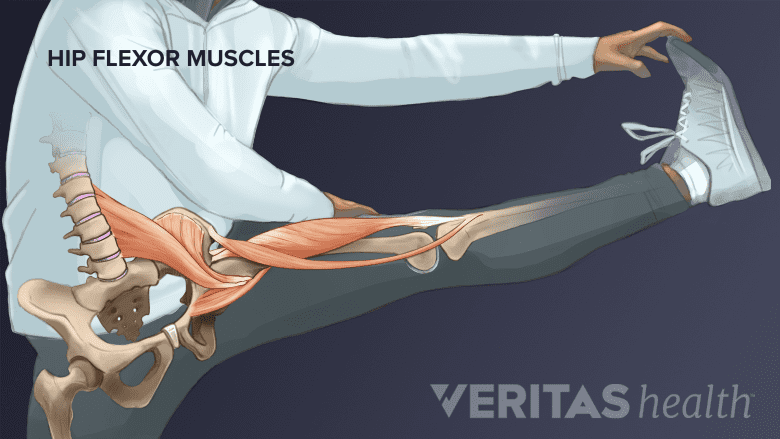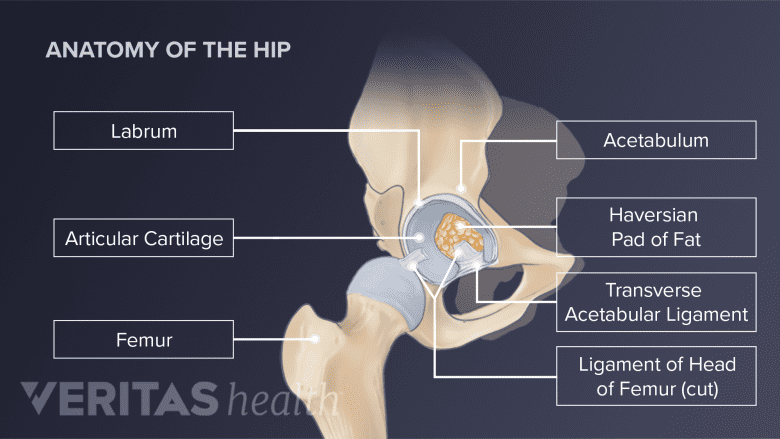Prolonged sitting increases stress within the hip joint and surrounding tissues. The pain tends to intensify while sitting and/or after getting up.
There are many ways to relieve hip joint pain that worsens with sitting, including activity modification and self-care, followed by non-surgical medical treatments.
Here is what you need to know about how sitting causes hip joint pain and tips and approaches to reduce the pain.
Sitting causes hip joint pain due to muscle imbalances

Sitting for long hours makes the hip flexor muscles short and tight.
When you sit for prolonged periods, your hip and core muscles undergo several changes.
- Your hip flexors become short and tight – these are the muscles in the front of your hip and thigh that help you raise your leg or bend your knees. See Understanding Hip Flexor Pain
- Your core muscles become weak – these are the muscles in your abdomen and lower back responsible for stabilizing your spine and pelvis
A combination of tight hip flexors and a weak core causes or flares hip joint pain due to:
- Impaired muscle function: Tight hip flexors and weak core muscles create an imbalance that increases stresses in your hip, lower back, and pelvis.
- Inflamed hip flexor tendons (tendonitis): The tight hip flexors and a weak core tend to stress the hip tendons, leading to hip tendonitis pain, particularly when getting up from a seated position. See Causes of Hip Flexor Pain
- Snapping tendons: Muscle tightness in the core and hip may cause the hip tendons to become tight and slide over bone while bending the hip to sit down – and then snap loose when tension releases after sitting, creating snapping hip sounds and pain within the hip joint or in front of it. See 3 Types of Snapping Hip Syndrome
- Reduced proprioceptive stimulation: Weak muscles in the hip and core reduce hip joint movement, causing pain. In general, the less movement a joint receives, the more pain-sensitive it becomes. See Proprioception: Making Sense of Body Position
Weak core muscles lead to poor sitting postures, such as shifting your weight by leaning to one side or slouching – further stressing the hip joint and disc spaces within your lumbar spine.
Extended sitting increases stresses within the hip joint

Sitting increases pressure inside the hip joint, stressing joint structures like the labrum.
Prolonged sitting, or sitting for 8 hours a day, keeps your hip joints in a continuously bent position. The constant engagement of the joint surfaces increases stresses within the joint, contributes to pain and stiffness, and creates a deficit that can be difficult to erase with just one hour of motion.
Over time, these stresses increase pressure on the hip bones, cartilage, and labrum.
- Increased pressure on the hip labrum: The labrum is a ring of soft tissue that acts like a gasket, cushioning the ball and socket hip joint. Tight hip flexors from prolonged sitting pull on this labrum, leading to overstretching, fraying, or a labral tear. These labral changes cause deep joint pain, instability, and clicking or snapping sensations in the hip while sitting.
- Abnormal contact between joint surfaces: Sitting for extended periods tends to cause the bones to rub abnormally, especially if there are bony bumps or irregularities, as found with hip impingement syndromes (such as femoroacetabular impingement). This friction irritates the joint and the surrounding tissues, leading to sitting hip pain.
- Inflammation of the joint’s cushioning sacs: Inflammation of the fluid-filled sacs – bursae – cushioning the hip joint is often triggered by sitting on hard surfaces for extended periods, leading to lateral pinpoint pain or bursitis pain and possible swelling near the hip.
- Wear and tear of the joint surfaces: Sitting sometimes exacerbates the symptoms of hip osteoarthritis, and pain tends to increase when rising from a seated position. Sitting can also accelerate osteoarthritis contributing to pain while sitting and or pain transitioning from sitting to standing. See 5 Gentle Exercises for Hip Osteoarthritis Pain Relief
Hip joint pain usually begins after a few minutes of sitting or while bending to sit down or stand up. Reclining, lying on the back, or moving around often brings temporary relief.
5 Tips to relieve hip joint pain
Try these self-care tips to quickly reduce hip joint pain while sitting:
- Ice therapy: For acute, throbbing pain, apply an ice pack to the front and side of your hip for about 15 to 20 minutes to calm inflammation and pain and provide a quick numbing effect. Keep a towel or cloth between the ice pack and your skin to prevent an ice burn and skin irritation. See 3 Useful Tips for Icing Your Injury
- Heat therapy: If you have a dull ache, place a heat pack on the front and side of your hip for about 15 to 20 minutes to loosen tight muscles and improve blood flow to the area. Keep a towel or cloth between the heat pack and your skin to prevent skin burns.
- Side sleeping: If you are a side sleeper, place a small pillow or rolled-up towel in between your thighs to alleviate pain in the hip opposite the one in contact with the mattress. This position keeps the pelvis and hips in a supported and neutral position and reduces torque in the hips.
- Bracing: Supporting the sacroiliac joints of the pelvis with an “SI Joint” belt can often relieve hip pain as the thin brace slightly compresses the hips. It is typically used in treating hip pain associated with pregnancy.
- Massage: You can use a tennis ball or a foam roller to massage your painful hip joints.
- Tennis ball hip massage is great for targeting specific pressure points.
- Place a tennis ball on the floor and sit on top of it, focusing on the tender areas along the side of the buttock, near your hip joint.
- Lean your body weight onto the ball and gently roll back and forth, loosening tender and tight spots.
- Repeat on the other side.
Foam roller hip massage is ideal for relieving tension in large muscle areas.
For the hip flexors in front of your hip joint:
- Start by lying down, facing the floor. Get into a plank position by placing your forearms on the floor with elbows aligned below your shoulders.
- Place the foam roller under your left hip and bend your right knee to the side.
- Roll through the front of your hip and upper thigh for about 30 seconds, focusing on tender spots.
- Return to the starting position and repeat the steps on the other side.
For painful buttock muscles behind your hip joint:
- Sit on a foam roller with your knees bent and feet flat.
- Support yourself by placing your arms behind you.
- Keep your left foot firmly on the ground and cross your right ankle over your left knee.
- Slowly roll back and forth for about 30 seconds to a minute, focusing on tender spots.
- Return to the starting position and repeat the steps on the other side.
- Tennis ball hip massage is great for targeting specific pressure points.
10 Ways to reduce the risk of hip pain when seated
Incorporate these tips into your daily routine to reduce your risk of experiencing hip joint pain during or after sitting:
- Support your spine: Maintain a neutral spine with your shoulders back and relaxed, feet flat on the floor, and knees bent at a 90-degree angle while sitting.
- How it helps: A balanced sitting posture distributes your body weight evenly through your lower back and hips, reducing stress on the hip joints.
- Move often: Set a timer to get up and move around for a few minutes after every 30 minutes of sitting.
- How it helps: Motion in the hip joint releases synovial joint fluid, lubricating it and preventing bony friction.
- Perform dynamic sitting: While seated, gently perform these movements:
- Rock from side to side, transferring your seated weight from one hip to the other.
- Rock forward and backward, distending the belly and tucking it in.
- Roll your hips and pelvis in the direction of the clock in a small circle, clockwise and counterclockwise.
- How it helps: Gentle movement while sitting helps to imbibe or drive nutrients into the joints of your hips and low back. It also stimulates nerve endings that reduce the transmission of pain.
- Do simple hip stretches: Perform gentle stretches to prevent hip joint and muscle stiffness and improve blood flow to the pelvis and hip. See 3 Simple Stretches for Hip Pain Relief
- How it helps: Stretching exercises lengthen tight muscles, improve flexibility, and reduce tension in the tendons and joints.
Easy hip stretches include the kneeling hip flexor stretch and lateral lunge stretch.
- How it helps: Stretching exercises lengthen tight muscles, improve flexibility, and reduce tension in the tendons and joints.
- Invest in ergonomics: Choose a chair with adequate lower back support and adjustable features to ensure a well-supported posture. Use a footrest if your feet don't comfortably reach the floor.
- How it helps: A chair that supports your lower back prevents your spine from slouching and decreases strain on the muscles that connect your back to your hips. A footrest keeps your knees at a comfortable angle, preventing tightness in your hip flexor muscles.
- Reduce strenuous activities: Take breaks throughout the day and reduce strenuous activities, such as vacuuming and gardening, that aggravate your pain.
- How it helps: Taking breaks and reducing strenuous activities allows your hips time to recover and prevents further joint irritation.
- Strengthen your core: Keep your spine straight and slightly tuck your stomach in to engage your core muscles throughout the day while sitting. Incorporate core-strengthening exercises, such as planks and bridges, into your regular workout routine.
- How it helps: A strong core provides stability and support for your entire body, including your hips, and takes pressure off your lower back and hip muscles and joints.
- Maintain a healthy weight: Aim for a healthy weight through a balanced diet and regular exercise.
- How it helps: A healthy weight decreases the load on your hip joints, reducing or slowing down the wear and tear of the joints.
- Reduce inflammation through diet: Replace processed foods and drinks and unhealthy fats (such as seed oils) with whole foods such as fruits, vegetables, and whole grains, which are packed with antioxidants and nutrients that reduce inflammation.
- How it helps: Over time, the benefits of an anti-inflammatory diet contribute to reducing inflammation in the body, decreasing hip joint pain, and improving your overall hip health.
- Stay hydrated: Minimize caffeine, sodas, and sugary drinks, and drink more water to keep your joint’s articular cartilage lubricated.
- How it helps: Staying hydrated ensures your joint and articular cartilage produce enough synovial fluid for lubrication and smooth joint movements.
Some people find relief through alternative therapies such as acupuncture, manual manipulation, therapeutic massage, or certain types of yoga.
If your hip pain is not relieved through these measures or gets worse, consult a doctor who specializes in musculoskeletal pain, such as a physiatrist, chiropractor, orthopedic surgeon, or physical therapist, for an individualized evaluation and treatment plan.

